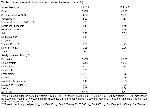Carcass characteristics: Except abdominal fat ratio (P<0.05), carcass characteristic means were similar in all groups (P>0.05). The active ingredients of spice extracts have positive effects on digestive enzymes and digestibility so dietary supplements of them enhance growth and carcass yield
14. Contrary to our study, Simsek et al.
25 reported that adding of plant extracts to ration had positive effects on the carcass yield. Besides Guler et al.
8 reported that dietary antibiotic (0,1 %) and black cumin seeds (one of five levels 0, 0.5, 1, 2 and 3 %) were fed to broiler chickens, except heart ratio means, liver, abdominal fat, legs, wings, breast and back+neck ratio means had been positively affected with black cumin seeds supplementation especially the level of 1% black cumin.
The authors explained the lack of effect by pointing out that the birds’ performance was already superior, leaving no room for growth enhancing effects of the additives. This statement could be in line with studies of Coates et al.2 and Hill et al.26 who demonstrated that well-nourished healthy chicks responded less to antibiotic supplements when they were housed in a carefully cleaned and disinfected place. Also the same results with our study have been reported by Simsek et al.27 in broilers fed with dietary essential oil mix (thyme, clove and anise).
Lipidemic effect: Spices and their extracts have lipotrope effects. Several active ingredients of spices influence lipid metabolism predominantly by mobilization of fatty acids, increase preferential utilization of fats and lower perirenal adipose weight28. In our study clove extract had also lowered perirenal adipose tissue weights and this effect was dose depended. Abdominal fat relative weights of clove extract groups were 24.07 and 16.89 percent in C–100 group, 33.33 and 27.03 percent in C-200 group, 34.57 and 28.38 percent lower than control and antibiotic groups, respectively. Similarly, several studies accomplished in this area have the same results with our study8,9,25.
Digestive Organ Size: Hill et al.26 indicated that dietary inclusion of antibiotics, given as growth promoters, reduced intestine weight by thinning the intestinal wall and shortening the gut, but in our study this effect was not noticed for antibiotic group. Small intestine relative weights were not statistically but numerically affected from dietary supplements in our study. It may be related to well-nourished healthy chicks responded less to antibiotic supplements when they were housed in a carefully cleaned and disinfected place. Similarly, Hernandez et al.29 reported that no differences were noticed for proventriculus, gizzard, liver, pancreas and large or small intestine weights in broilers fed with dietary essential oil at 21st and 42nd days of age.
The liver relative weights were not statistically but numerically higher in clove extract groups than the others. It may be related to the active ingredients of spice extracts enhance liver metabolism and increase liver weight30. The same result has been reported by Simsek et al.27 in broilers consumed dietary anise oil.
In vivo antimicrobial action: In general, clove extract and antibiotic supplementation decreased total coliform microorganism counts of small intestine of broilers at 21st and 42nd days of the experiment (Table 5). This study proved in vivo antimicrobial effect of clove extract with dose dependent. And the effective dose was found to be minimum 400 ppm for balancing gut microflora.
At 21st day of the experiment the coliform microorganism counts of 1 g small intestine content in C-400 group were 20.88 and 0.44 percent lower than control and antibiotic groups, respectively. However, at 42nd day of the experiment the lowest coliform microorganism population was found in antibiotic group. Fortunately, the difference between C-400 and antibiotic groups was only 0.06 percent. Small intestine coliform microorganism counts of C-400 group were 42.96 percent lower than negative control group. The results of the other clove groups were better than control group at 42nd day of the experiment.
A wide range of in vitro antimicrobial activity of spice extracts has been proved by previous studies11,12,14.
Guler et al.4 investigated whether a mixture of essential oil from thyme and anise with 0, 100, 200 and 400 ppm levels and antibiotic with 10 ppm level supplementation could have effects on the number of cecal coliform microorganism in broilers fed with corn-soy meal based rations. Chicks fed the diets containing essential oil mixture and antibiotic showed a reduced cecal coliform microorganism counts when compared to the negative control group. And they reported that the antimicrobial activity of essential oils has increased related to its dose.
A field study conducted by Köhler31 with a commercial preparation of essential oils showed a reduction of colony forming units of Clostridium perfringens as compared to the positive control diet containing zinc bacitracin at the level of 20 ppm. Similarly, a blend of capsicum, cinnamaldehyde and carvacrol lowered the number of Escherichia coli and Clostridium perfringens in ceca32. These results were in accordance with our results for antimicrobial activity of spice extracts in broilers.
In conclusion clove extract improved the carcass charecteritics slightly and have shown strong antimicrobial effect on total coliforms of small intestine. Our results justify the possibility use of 400 ppm clove extract as an alternative natural antimicrobial matter and growth promoter for poultry instead of antibiotics.
Acknowledgment
This work was supported financially by The Scientific Research Projects Council Unit of Firat University (FUBAP–1120) and was summarized from doctorate thesis







